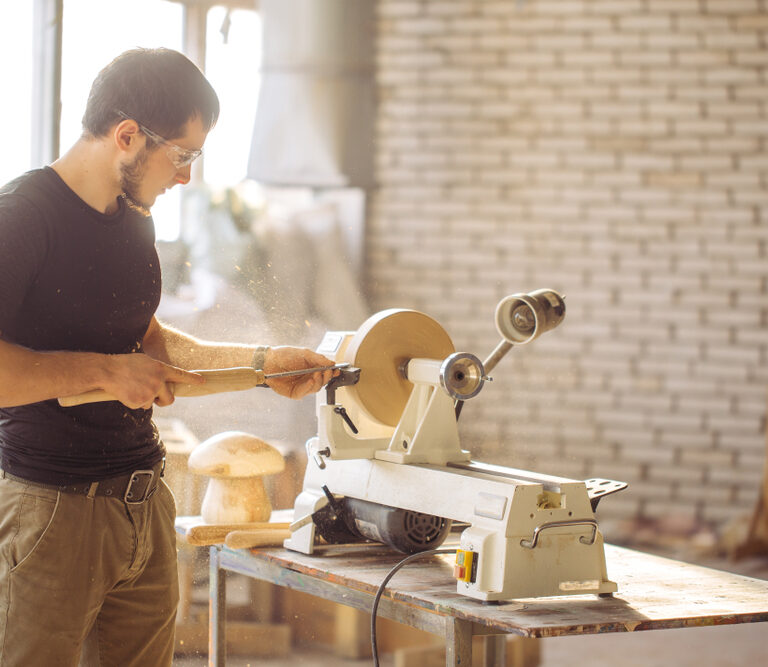Have you ever wanted to turn your own pens, pepper mills, or Christmas ornaments? If you’re searching for wood lathes, the answer is almost guaranteed to be yes.
Whether you are a complete beginner, novice, or experienced woodturner, mini lathes are often the best option for woodturning. They are cheaper and more practical than many of their larger counterparts, they fit easily in a workshop (which is probably already pretty full), and unless you are planning to make large bowls and furniture legs, a mini lathe will allow you to create almost anything you would need a lathe to make.
- What Makes a Good Mini Wood Lathe?
- Top 12 Best Mini Wood Lathes 2023
- 1. Best Overall Mini Wood Lathe: Nova 71118 Comet II DR
- 2. Mini Wood Lathe With Largest Swing: Delta Industrial 46-460
- 3. Best Budget Mini Wood Lathe: WEN 3421 Mini Wood Lathe
- 4. Best Mini Wood Lathe for Craft Shows: PSI Woodworking PENPAL Portable Penmaking Lathe
- 5. Best Premium Mini Wood Lathe: JET JWL-1221VS Wood Lathe
- 6. Sturdiest Mini Wood Lathe: RIKON 70-105 Mini Lathe
- 7. Best Included Mini Wood Lathe Accessories: PSI Woodworking KWL-1018VS Turncrafter Commander
- 8. Most Powerful Mini Wood Lathe: PSI Woodworking KWL-1218VS Turncrafter Commander
- 9. Most Portable Mini Wood Lathe: WEN 3424T Benchtop Wood Lathe
- 10. Best Lightweight Mini Wood Lathe: WEN 3420T Mini Wood Lathe
- 11. Best for Larger Projects: RIKON 70-100 Mini Lathe
- 12. Best Mini Wood Lathe for Kids: SHOP FOX W1704 Benchtop Lathe
- Making the Most of Your Mini Wood Lathe
- Take a Turn for the Better
What Makes a Good Mini Wood Lathe?
Swing, motor power, and variable speed are some of the most important factors to consider when looking to buy a lathe. These have slight variations, but one will suit your needs better than the others.
We’ve done all the work of comparing the best mini wood lathes on the market to minimize the tossing and turning you’ll do while trying to decide which one is best. Here’s what we looked at to find the best mini wood lathes on the market:
Swing and Center-to-Center
These measurements affect the size of the objects you can turn on your lathe. Manufacturers often present the swing as two numbers (e.g. 8” by 10”). The smaller number (the swing) indicates the amount of space between the spindle and the lathe bed, i.e. the maximum diameter of the wood blank you can start with. The larger number indicates the distance between the spindle centers, i.e. the maximum length of the blank you can use.
Motor Power
A stronger motor is less likely to stall when working with harder or knotted wood. See this section for more information about why motor strength is important.
Most motors for mini wood lathes are measured in horsepower (HP), although some are measured in amps. We have included an approximate conversion to HP for easy comparison.
Variable Speed
This is important if you plan on working with different types of wood and allows you to make the smoothest cuts at various stages of the turning. A lower speed is better when roughing out your blank, and a higher speed towards the end will produce a smoother finish. See this section for more information about how to use variable speed for the best results.
Stability
Stability affects the accuracy of your turning and mini wood lathes are potentially more unstable than their larger counterparts as they cannot rely on the weight of the machine to stabilize it.
As the mini lathes outlined below are the best on the market, this is generally not an issue in these models, but it is interesting to see how various manufacturers have ensured stability. Some make the base out of cast iron to add weight, others include an easy way to bolt your mini lathe to your workbench.
Portability
One of the drawcards of a mini wood lathe is the ability to easily move it around your workshop or transport it to other locations. This is an important feature for those who do not have a dedicated space in their workshop for it to live and want to stow it away when it’s not in use, and for woodturners who want to take their lathe to craft shows and club meets.
Extras and Attachments
These are tools most woodturners need but often have to buy separately; it’s a bonus if they come with the machine. Extras could include various chucks, faceplates for non-spindle work, or more than one tool rest (usually in different sizes). We’ll let you know which mini lathes come with which extras. Read this section to learn more about which tools and attachments you’ll need/want to use with your lathe.
The smaller, benchtop lathes on the market are sometimes split into two categories, mini and midi wood lathes. As manufacturers don’t always agree on the line between these two categories, we have included both here as the lathes can all stand on a benchtop and are (mostly) portable for moving around your workshop or traveling.
For this guide, we have limited our selection to lathes with a swing of around 12 inches and below, and a center-to-center measurement below 22 inches.
Now that we’ve covered what to look for in a mini wood lathe, let’s check out the best options available on the market today.
Top 12 Best Mini Wood Lathes 2023
1. Best Overall Mini Wood Lathe: Nova 71118 Comet II DR
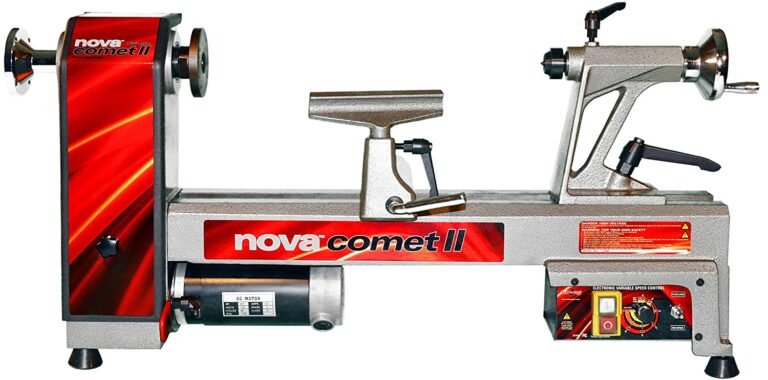
Editor’s Rating:
Swing: 12” x 16.5.” This is a slightly shorter center-to-center than most lathes with a 12-inch swing but there is a 42-inch extension bed available. You will be able to turn almost anything you want with this lathe.
Motor: 3/4 HP. This is one of the more powerful motors, over the average ½ HP you’ll find on many mini wood lathes. It will allow you to work with a variety of materials without worrying about how it will manage larger items.
Variable speed: 250 to 4000 RPM. There is a mix of manual and automatic speed adjustment in this lathe. It has a manual three-belt system with a dial for automatic speed adjustments within each of the three ranges. The RPM is shown on a digital display panel for better control over your speed.
Stability: This lathe is made of cast iron and has great stability without needing to be bolted down.
Portability: The Nova Comet II weighs 82 pounds which is about average for a lathe with a 12-inch swing. It is on the larger, heavier side of mini lathes so it is less portable than other mini wood lathes. It is easy enough to travel with, but you probably won’t want to move it from your workbench to a separate storage area too often.
Extras: This machine comes with a 3-inch faceplate, a 6-inch tool rest, reversible rotation, a spur drive center, a live tailstock center, a knockout bar, and a tailstock handwheel unit.
Overall: This mini wood lathe is a good all-rounder. It is on the higher end of size and strength while still being portable enough to travel with.
Pros
- Strong motor
- Reversible rotation
- Digital speed readout panel
- Portable
Cons
- Shorter center-to-center
2. Mini Wood Lathe With Largest Swing: Delta Industrial 46-460
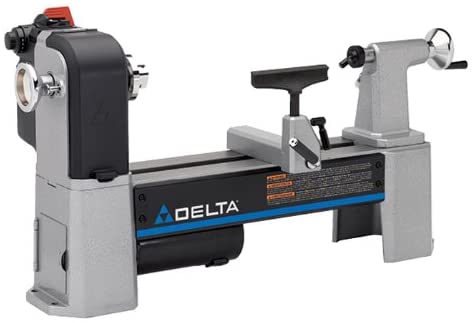
Editor’s Rating:
Swing: 12.5” x 16.5.” This is the largest swing available in a mini lathe but a relatively short center-to-center. There is an option to buy a base extender which will increase the center-to-center up to 42 inches, allowing you to turn longer items.
Motor: 1 HP. This is the most powerful motor available in mini wood lathes which is ideal for turning larger items that can strain smaller motors.
Variable speed: Like the Nova Comet II, there is a three-belt pulley system with various speeds within each range. It does not have a digital display but does have a chart showing the speed at each dial setting within the three ranges for easy use.
Stability: This lathe weighs 97 pounds and is made of cast iron giving it great stability, especially when turning larger items.
Portability: As it is one of the heaviest mini wood lathes on the market, you probably won’t be moving this lathe around your shop or traveling much with it. However, it is a lot lighter, and therefore more portable, than the JET JWL-1221VS which is its closest competitor in swing-size and motor strength. If you are looking for a great option for traveling though, consider PSI Woodworking PENPAL Portable Penmaking Lathe.
Extras: This machine comes with a live center, reverse function, knockout bar, 6- and 10-inch tool rests, 30inch faceplate, wrenches (for speed adjustment), and a tool holder for adjustment wrenches.
Overall: This mini wood lathe is perfect for those wanting to turn larger items like bowls and furniture legs. You get most of the function of a full-size lathe for a lower price and less space taken up in your workshop.
Pros
- Large swing
- Powerful motor
- Reversible rotation
- 5-year warranty
Cons
- Reverse and forward rotation are switched from their expected positions
- Heavy/ limited portability
3. Best Budget Mini Wood Lathe: WEN 3421 Mini Wood Lathe
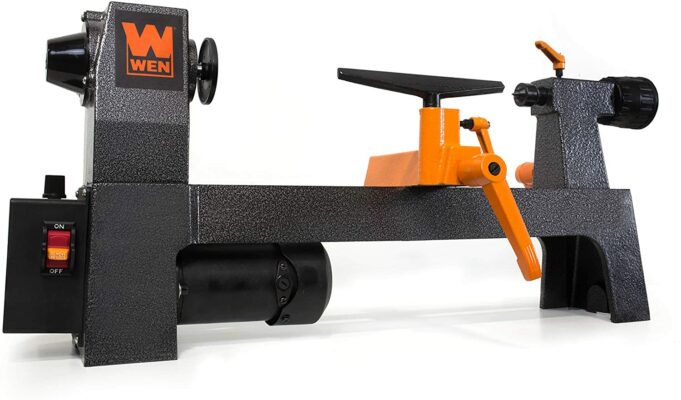
Editor’s Rating:
Swing: 8” x 12.” This is on the smaller side for a mini wood lathe but will still allow you to turn pens, ornaments, and other small items.
Motor: 3.2 Amp (approx. 1/3 HP). Only slightly less powerful than the average mini wood lathe. It does restrict the amount of wood you can take off in one pass but works well enough for beginners and those wanting to turn small items.
Variable speed: 750 to 3200 RPM. Instantly adjustable using a dial, no extra manual changes necessary.
Stability: The WEN 3421 mini wood lathe is not a very heavy machine but can be bolted onto a workbench or stand for additional stability.
Portability: This lathe weighs just under 45 pounds and can easily sit on your workbench then be stored somewhere else when not in use. Its size and weight also make it a good option for those who want to travel with their lathe.
Extras: This machine comes with two different-sized tool rests, a knockout rod, a flat wrench, and a 2.3-inch faceplate for non-spindle pieces.
Overall: This lathe is cheaper than many comparable mini wood lathes. It has an average motor and swing size, making it a good starter lathe for those who want to try woodturning but don’t want to invest a lot of money. If you are ready for more of an investment, check out the JET JWL-1221VS Wood Lathe instead.
Pros
- Variable speed using a dial
- Portable
- Great price
- 2-year warranty
Cons
- Smaller motor
4. Best Mini Wood Lathe for Craft Shows: PSI Woodworking PENPAL Portable Penmaking Lathe
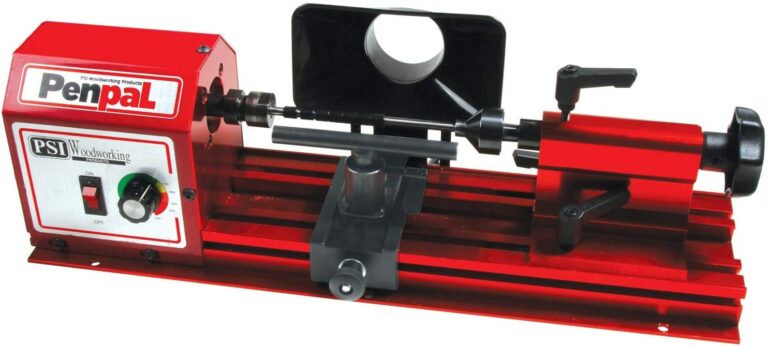
Editor’s Rating:
Swing: 5.5” x 8.” Even though it’s a lot smaller than other mini wood lathes, if you plan on using your lathe mostly for pens or miniatures, this lathe has plenty of swing.
Motor: 1/5 HP. The motor works well for wood blanks. It struggles with harder materials like acrylics although it is manageable with the right technique and using lower speeds.
Variable speed: 0 to 4300 RPM. Speed is adjusted using a dial; no need to stop the lathe while changing speed.
Stability: This lathe comes with a flange and can be bolted to a work surface for stability.
Portability: At just 15 pounds, this mini wood lathe is ideal for moving it around your workshop and traveling. You could even take it on holiday with you as it will easily fit into a car or caravan and can be set up on any sturdy table or stand.
Extras: This lathe comes with a pen mandrel shaft with collet closer nut for mounting, a mandrel saver, five 7mm bushings, a 7mm drill bit, and two collet wrenches.
Overall: Although it is quite limiting in terms of the different items you can make, if you are primarily interested in turning pens or miniatures, or if you have concerns about weight and size, this is the lathe for you.
Pros
- Portable
- Lightweight
- More speeds than other mini lathes
- Great for pen-making
Cons
- Limited swing size
- Limited motor strength
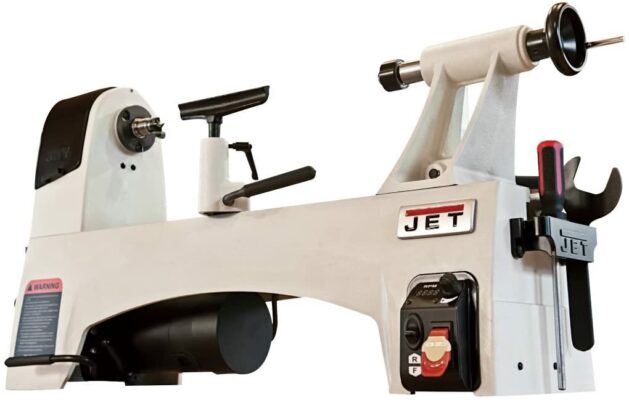
Editor’s Rating:
Swing: 12” x 21.” This is a larger center-to-center than any other mini wood lathe. While you can buy extension beds for the other lathes, you probably won’t need to with this one, leaving more money for tools and accessories.
Motor: 1 HP. This is the most powerful motor available on a mini wood lathe but is surprisingly quiet.
Variable speed: 60 to 3600 RPM. The speed of this lathe is a combination of digital and manual, controlled by three belts. Each belt allows you to work within a range of speeds, displayed on an LCD screen, that can be adjusted using a rotating dial. The belt only needs to be changed manually when a different range is required.
Stability and portability: This is the largest, heaviest cast iron lathe that still qualifies as a mini wood lathe. It is very heavy, and many users mount this lathe to a separate stand where it can stay, rather than using up their workbench surface, as it is difficult to move. This is not a good option if you want to travel with your lathe. However, if you want to try your hand at eccentric woodturning, the weight and stability of this lathe are ideal.
Extras: This machine includes a reversible rotation feature, a tool rest, and an indexing head.
Overall: This is a great lathe for those who want to do slightly larger projects but don’t want to pay thousands of dollars for a full-sized lathe. It is more expensive than most mini wood lathes but also offers a stronger motor and more control over your speed.
Pros
- Most powerful motor
- Large swing
- Variable speed with digital display
- Reversible rotation
- 5-year warranty
Cons
- Difficult to move alone
- Expensive for a mini wood lathe
6. Sturdiest Mini Wood Lathe: RIKON 70-105 Mini Lathe
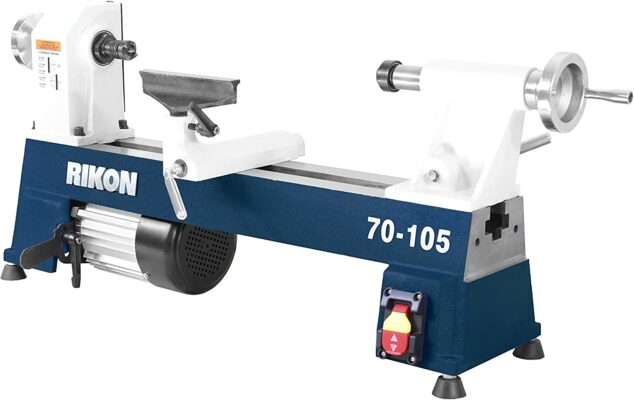
Editor’s Rating:
Swing: 10” x 18.” There is also the option to buy a base extender which will increase the center-to-center, allowing you to turn longer items.
Motor: ½ HP. The motor comes with cooling fins preventing it from overheating. It is quiet but powerful enough for a smooth turning experience.
Variable speed: Limited to 5 settings – 500, 1175, 1850, 2225, and 3200 RPM. Changing the speed is a manual process using a belt and pulley system that can disrupt your flow of work. Most users find the manual setting easy to understand and use, although it might be difficult for younger users.
Stability: Most of this lathe is made from cast iron, making it very sturdy and allowing you to forgo the need to bolt it to your workbench. The weight, combined with the rubber feet, minimizes vibrations for a smooth turning experience.
Portability: This lathe is on the heavier side at 74 pounds but is the most portable 10-inch lathe.
Extras: This machine comes with rubber feet, one tool rest, a spur center, a live center, a 6-inch tool rest, and a set of wrenches (for speed adjustment).
Overall: This mini wood lathe is great for beginners and more experienced turners alike. It is easy to set up and use and can handle a variety of woods and project types.
Pros
- Great stability
- Runs smoothly and quietly
- Very user friendly
- Portable
- 5-year warranty
Cons
- Manual speed adjustment
7. Best Included Mini Wood Lathe Accessories: PSI Woodworking KWL-1018VS Turncrafter Commander
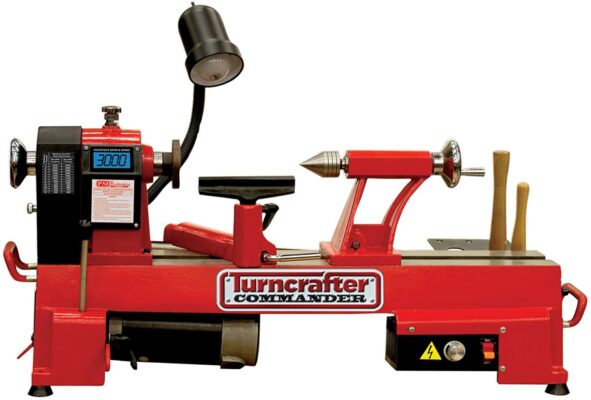
Editor’s Rating:
Swing: 10” x 18” which is a standard size. There is an extension bed up to 42” available for turning longer items.
Motor: ¾ HP. This is the most powerful motor for a lathe with a 10-inch swing and more powerful than some lathes with a 12-inch swing.
Variable speed: 500 to 3600 RPM split by two belt positions with adjustments made using a dial.
Stability: Made of cast iron and weighing 82 pounds, this mini lathe is heavy with a sturdy base ensuring stability.
Portability: This mini lathe is quite heavy but comes with well-placed handles to move the lathe to another place more easily.
Extras: Handles, 6-inch tool rest, tool rack, 3-inch faceplate, spur drive center, tailstock live center, set of 4 hex wrenches, rubber feet, knockout rod, Philips screwdriver, adjustable light source, and safety goggles.
Overall: This is a powerful mini wood lathe with a decent swing size. It is a good option no matter your level of expertise as it can handle a variety of materials and rough treatment. One negative to note is the poor quality of the light attachment.
Pros
- Powerful motor
- Lots of extras
- 3-year warranty
Cons
- Poor quality light attachment
8. Most Powerful Mini Wood Lathe: PSI Woodworking KWL-1218VS Turncrafter Commander
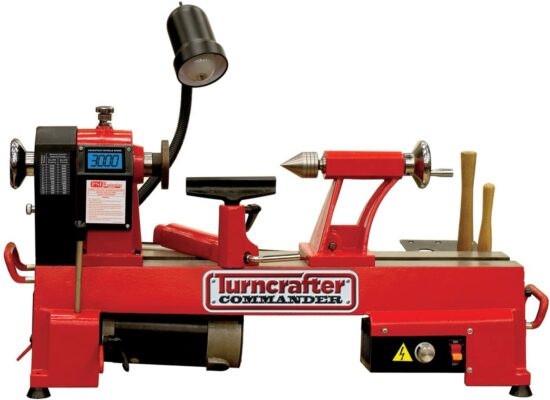
Editor’s Rating:
Swing: 12” x 18” This is one of the largest swing sizes available for a mini lathe and will allow you to make most projects, including some mid-sized bowls. There is an extension bed up to 42” available for turning longer items.
Motor: 1 HP. This is the most powerful motor for a mini wood lathe. You will be able to use a variety of materials for projects without compromising on stability, details, or the smoothness of the finish.
Variable speed: 500 to 3800 RPM split by two belt positions with adjustments made using a dial.
Stability and portability: This lathe is made of cast iron and weighs 106 pounds, one of the heaviest mini wood lathes only beaten by the JET JWL 1221VS Wood lathe. It is very heavy and not one you’d want to travel with.
Extras: Handles, 6-inch tool rest, 12-inch tool rest, tool rack, 3-inch faceplate, spur drive center, tailstock live center, set of 4 hex wrenches, rubber feet, knockout rod, Philips screwdriver, adjustable light source, and safety goggles.
Overall: Like its smaller, 10-inch model, this is a powerful mini wood lathe with a decent swing size. It is a good option no matter your level of expertise as it can handle a variety of materials and rough treatment. A common complaint is the poor quality of the light attachment.
Pros
- Powerful motor
- Lots of extras
- 3-year warranty
Cons
- Poor quality light attachment
9. Most Portable Mini Wood Lathe: WEN 3424T Benchtop Wood Lathe
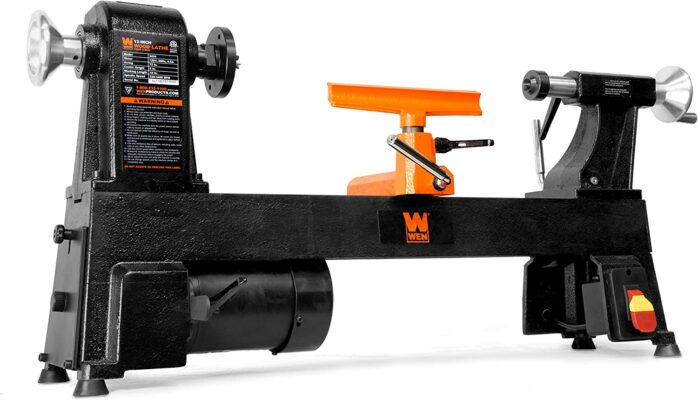
Editor’s Rating:
Swing: 12” x 18.” This is one of the larger sizes of mini wood lathes allowing for greater variety in the types of items that you can turn on it. Items you can turn include medium-sized bowls, as well as the usual smaller items. There is also an extension available for longer work.
Motor: 4.5 Amp (approx. ½ HP). This is an average motor for a mini wood lathe that can handle rough and hard wood although it does better with prepared stock.
Variable speed: 5 Speeds – 520, 900, 1400 2150, and 3400 RPM. While not as versatile as other mini wood lathes, the variable speeds on this lathe covers the basics that you will need when woodturning. Changing speeds is manual and based on a belt and pulley system.
Stability: This mini lathe is made of cast iron and its heavy base ensures stability, preventing walking and wobbling, even at high speeds. Larger items might affect the stability as it is lighter than other 12-inch mini wood lathes, and the lathe should be bolted down when turning large items.
Portability: At 70 pounds, this lathe is more portable than many of the others on this list. It is the lightest lathe with a 12-inch swing making the most portable of the larger mini wood lathes.
Extras: 3-1/8-inch faceplate, 8-inch tool rest, and accessory holder. The head- and tailstock are tapered for compatibility with accessories.
Overall: If you are wanting to try your hand at making bowls and larger items than pens and miniatures, this is a great lathe that will accommodate larger pieces. It is also the lightest of the larger mini lathes making a good option for traveling with.
Pros
- Large swing with purchasable extension
- Great stability
- Portable
- 2-year warranty
Cons
- Manual speed adjustment
- Limited to 5 speeds
10. Best Lightweight Mini Wood Lathe: WEN 3420T Mini Wood Lathe
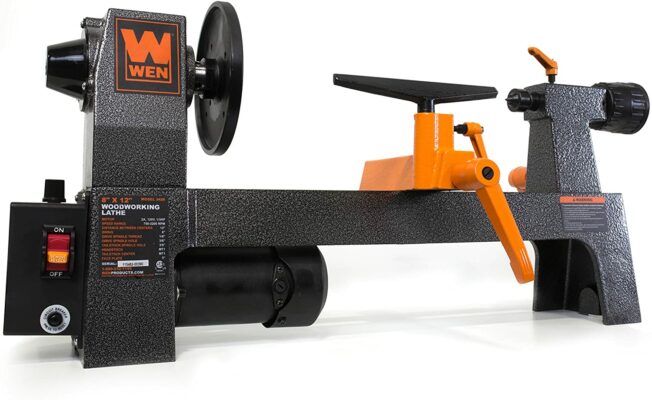
Editor’s Rating:
Swing: 8” x 12.” This is one of the smaller mini wood lathes but will still allow you to turn narrower items like pens, spindles, and candlesticks.
Motor: 2 Amp (approx. 1/3 HP). Although it’s relatively small for a mini lathe this motor can handle a variety of materials with careful turning.
Variable speed: 750 to 3200 RPM. Speed is adjusted easily using a dial.
Stability: The WEN 3420T is lightweight but stable enough for most work. Larger items can cause the lathe to wobble slightly.
Portability: At just over 40 pounds, this mini lathe is more portable than most and can easily be moved from the workbench to a cupboard or storage area.
Extras: 5-inch faceplate, two tool rests of different sizes, a flat wrench, a knockout rod, a headstock spur center, and a tailstock cup center.
Overall: This is a great standard mini wood lathe. It is much cheaper than other comparably sized models and runs well. Some users have issues with the tailstock, but the manual explains how to manage the lathe’s quirks.
Pros
- Portable
- Variable speed
- Includes 5-inch faceplate
- 2-year warranty
Cons
- Slightly unstable when turning larger items
- Some issues with the tailstock (covered in the manual)
11. Best for Larger Projects: RIKON 70-100 Mini Lathe
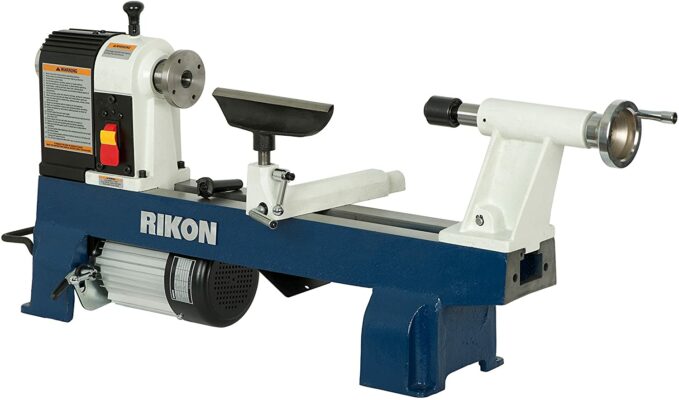
Editor’s Rating:
Swing: 12” x 16.” This is one of the largest swing sizes available in a mini wood lathe giving you greater freedom in the size of your woodturning projects than other mini lathes. There are also multiple extension beds available for this model.
Motor: ½ HP. This is a standard motor size for a mini wood lathe. It will allow you to turn most projects easily but might struggle with some of the larger projects at high speeds.
Variable speed: Six speeds – 430, 810, 1230, 1810, 2670, and 3900 RPM. This lathe needs to be manually adjusted to change the speed. This can disrupt the flow of your work as you will need to stop the machine before changing the speed. However, the mechanism is easy to use with a quick-access panel and handy chart for determining the ideal speed.
Stability: This lathe weighs 88 pounds, making it very sturdy. It can also be bolted to a bench or stand. The available stand for this model can be adjusted to your preferred work height.
Portability: As it is one of the heavier mini wood lathes, the portability of this lathe is limited compared to others but it does come with flip-up handles for when you do need to move it.
Extras: This mini wood lathe comes with flip-up handles, an 8-inch tool rest, a self-ejecting tailstock (no need for a knockout bar), a 12 position indexing head, an adjustment wrench, and a tool holder.
Overall: This is a large, solid lathe with a good motor that will allow you to turn bigger pieces than most mini wood lathes.
Pros
- Large swing
- Good motor
- 2-year warranty
Cons
- High price compared to other mini lathes
- Manual speed adjustment
12. Best Mini Wood Lathe for Kids: SHOP FOX W1704 Benchtop Lathe
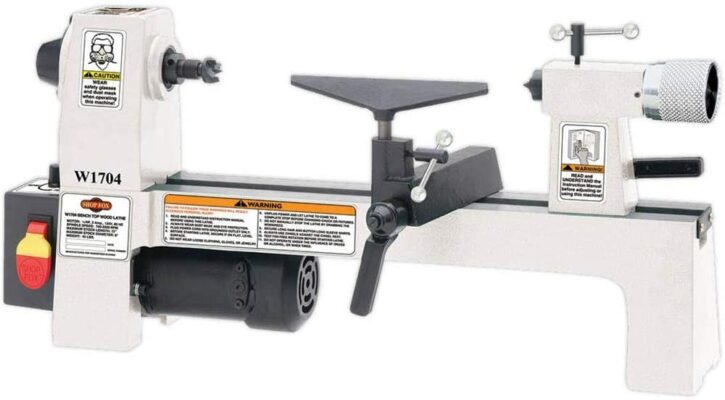
Editor’s Rating:
Swing: 8” x 12.” This is on the smaller size for a mini wood lathe but has enough room for most woodturning projects.
Motor: 1/3 HP. One of the weaker motors for a mini lathe. It struggles with harder materials, especially at lower speeds, but is great for smaller items and softer woods.
Variable speed: 750 to 3200 RPM. Speed is adjusted easily using a dial.
Stability: This mini wood lathe is made from cast iron, the weight of which adds to the stability when turning. It can also be bolted to a workbench or stand for additional stability.
Portability: Weighing just over 50 pounds, this lathe is lighter than comparable lathes making it easier to move around your workshop and better than others for traveling.
Extras: This lathe comes with two tool rests (4-1/2-inch and 7-inch) and a 5-3/4-inch faceplate. The tool rests are quite rough which could affect the quality of the finish on your projects.
Overall: If you’re looking for a dependable, easy-to-use machine for turning smaller items, this is a good option. It has a kid-friendly speed adjustment dial and easy-to-understand operating instructions for training the next generation of woodturners.
Pros
- Portable
- Good for kids and beginners
- Inexpensive
Cons
- Weaker motor
- Rough tool rests
Making the Most of Your Mini Wood Lathe
Unless you are planning to make large bowls and furniture legs, you are unlikely to need anything much larger than a mini wood lathe. Whether you are a beginner or have years of experience under your belt, as your skills progress you will still get everything you need from your mini lathe without needing to upgrade.
In general, the prices are lower, the size is more manageable in the average workshop, and you can turn almost anything you can think of, barring exceptionally large or lengthy items. Even then, many mini wood lathes can be modified with an extension bed (up to 42-inches in some cases) which will allow you to turn much longer items without needing to buy a full-sized lathe.
What Can I Make on a Mini Wood Lathe?
Pens are popular items to turn on a mini wood lathe, but you’re not limited to pens. Mini wood lathes are ideal for very detailed items like chess pieces, Christmas (or other holiday) ornaments, and spindles for smaller furniture like chairs and stools.
Other items you can turn on a mini lathe include:
- Small bowls e.g. for trinkets
- Cups/goblets
- Saltshakers and pepper mills
- Drawer and doorknobs/handles
- Bottle stoppers and openers
- Candlesticks
- Bangles
- Rings
- Chess pieces
- Harry Potter wands
- Beads
- Furniture feet
- Baseball bats (although you’d need an extension bed for this one)
As you can see, there’s more to make than pens. The smaller mini wood lathes, like the PSI PENPAL, are ideal for pen-making but tend to be limited to projects of that size. The larger lathes with a swing of 10 inches or more, like the JET JWL-1221VS, are much more versatile in terms of your project options.
How to Choose the Right Mini Wood Lathe for Your Needs
If you want to turn wider items like bowls, you should opt for a mini wood lathe with a larger swing. However, as the swing size increases, so does the weight. Lathes with a larger swing will offer better versatility in terms of project options but will be heavier to ensure stability, making them less portable.
Turning long items like furniture legs and large candlesticks will need a larger center-to-center and heavier base to ensure stability. These also tend to be less portable as the longer bed can be awkward to transport.
Lathes with a smaller swing will be more portable but usually limit the size of your woodturning projects. If you’re happy sticking to smaller items like pens and miniatures, you have limited space in your workshop (or budget!), or portability is important to you, then one of the smaller mini wood lathes would be a great option.
Why the Big Fuss Over Motor Power?
The strength of your motor determines the size of the projects you can turn smoothly, and the types of materials you can use easily.
Softer woods, like maple, poplar, and most green woods, are easier to shape and don’t need a powerful motor. Harder woods and materials like acrylics and epoxy tend to have a smoother finish and better durability than softer materials but do require a motor that has at least 1/3 HP for an easy turning experience.
A motor that is too weak will stall when you try to shave wood too deeply at a pass, or if the wood is particularly hard/your gouge gets caught in a knot. A stronger motor will allow you to work with harder wood like hickory, and rough, knotted wood-like “found” wood from a firewood pile. Working with these harder and “flawed” materials can give great satisfaction and result in stunning pieces like live-edge bowls.
Why Is Variable Speed So Important?
Turning at the right speed gives you maximum power transfer and control over your piece. You should start turning on a low speed as this gives you more power to true up rougher wood without your motor stalling.
If your lathe is wobbling, or your gouge is jumping around, go back to a lower speed as this usually means there are still some rough areas, or your wood is hard and needs more power. Turning at a lower speed means that there is more power for harder, rougher woods and you will be able to use deeper cuts while shaping your piece.
As the wood gets smoother you can work at a higher speed to shape it faster. Higher RPMs are less powerful and so are not a good speed to work at while truing your wood or working with harder materials. However, higher speeds are useful towards the end of the turning process for fast shaping, final detailing, sanding, and finishing.
Which Way to Turn?
Reversing the rotation of your piece while sanding helps to create a smoother finish. While turning you cut across the grain, sanding in the forward position is with the grain, making the fibers lie down but remain rough. Sanding in reverse goes against the grain and smooths the wood fibers.
In lathes without a reverse function, the same effect can be achieved by remounting the piece backward, but this can be time-consuming, and without a chuck, the piece can be difficult to recenter. If you plan on turning practical pieces like bowls and candlesticks where the quality of the finish is important, the reverse rotation function will help you achieve the best possible finish with minimal effort.
The reverse function can also help with difficult grain patterns, creating interesting helix shapes in spindles and candlesticks, and turning threads into items like lidded boxes for a left- or right-hand thread as desired.
How Much Does Woodturning Cost?
Woodturning can become an expensive hobby and a source of contention with anyone who shares a budget with you. Although you can make a variety of items with only your lathe and a set of turning tools, many accessories will become essentials as you progress in the craft and start making more complex items. Save a portion of your budget for all the extras you will inevitably “need.”
At the very least, in addition to your mini wood lathe you will need:
Turning Tools
There are so many different tools to choose from and they come in multiple shapes and sizes; roughing gouges, bowl gouges, parting tools, scrapers, skew chisels, and grinding wheels, to name a few. It can be overwhelming. To get started as a beginner, these are the six turning tools you will need for turning basic spindles and how to use them.
There is some debate in the woodturning world over whether traditional or carbide tools are better for turning. Carbide tools have removable tips that can be rotated and replaced easily. They don’t need sharpening as you can simply replace the head when it gets blunt. There’s also less of a learning curve than using traditional tools. Traditional tools are usually made of one long piece of steel with a wooden or plastic handle. They do need to be sharpened but cut better and cost less in the long run.
Wood/Stock/Pen Blanks
You will probably never have enough raw material to turn all the projects you have in mind, especially once you have been bitten by the turning bug. Wood and blanks can become an investment comparable to and even exceeding the price of your mini wood lathe. Some materials, like hardwoods and artisanal pen blanks, can be expensive as they are rare or difficult to produce. However, they result in beautiful pieces and so your wallet gets thinner and thinner until it starts to look like it needs a weekend at grandma’s house.
Finishes
To ensure your turned pieces will last, they need to be finished in some way. Oils, waxes, varnishes, and even CA glue bring the color and grain of the piece to life as well as protecting it from general wear and tear during use, or from weathering, if it is an ornament or display piece.
Other accessories and tools you might like to buy later include:
- Chucks – for holding items like bowls and goblets while you are hollowing them out
- Another bigger or better tool rest including curved tool rests
- A drill chuck – for starting the hollow of bowls and other hollow pieces.
- A grinder for sharpening your tools
- Various calipers
- Extension beds
If the accessory is one that needs to be attached to your lathe, like a chuck or grinder, make sure it is compatible with your machine and can be attached properly. Most manufacturers provide a variety of accessories for the lathes that they sell.
If you know you will be buying lots of accessories for your mini wood lathe, you might want to check that they are available in the right size for your lathe. You should be able to find them easily unless they are uncommon attachments, but even then, you can usually buy an adapter or find one from another manufacturer that will work.
Pro Tips for Using Your Mini Wood Lathe
To help get the most out of your mini wood lathe, keep the following tips in mind.
- Bolt smaller lathes to a board that you can then clamp to your workbench for quick and easy set-up and removal.
- A good light source is important for safety as you need to see what you are doing to avoid cutting yourself or getting catches. It also allows you to see better for fine detail work.
- If your lathe starts wobbling, go back to a lower speed and keep taking off wood until your piece is centered before trying again.
Take a Turn for the Better
Whether you want to turn bowls or pens, whatever your woodturning needs and level of expertise, there is a mini wood lathe out there for you. Woodturning is a fun hobby and it’s easy to get carried away and spend a lot of money on a lathe and all the “necessary” accessories. You can justify it by telling yourself it’ll pay for itself when you sell the items you’ve turned. Maybe it will, but at the end of the day if you have a lathe that runs smoothly, has a swing large enough for the items you want to turn, and a motor powerful enough to handle a variety of materials without stalling, you can’t go wrong.
